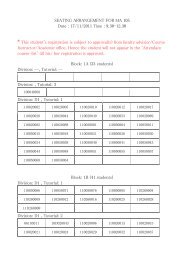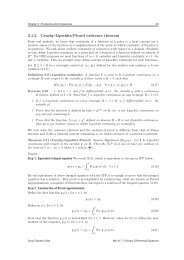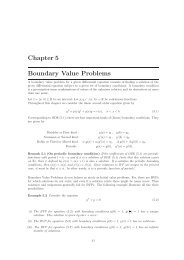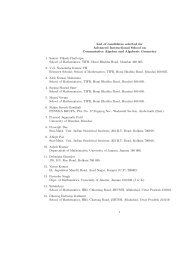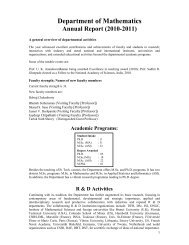the Masters' Thesis of S. Sundar
the Masters' Thesis of S. Sundar
the Masters' Thesis of S. Sundar
Create successful ePaper yourself
Turn your PDF publications into a flip-book with our unique Google optimized e-Paper software.
and let ti = ρ(ei). Let �t =<br />
⎛<br />
t1<br />
⎜<br />
⎝ .<br />
t2<br />
tn<br />
⎞<br />
⎟<br />
⎠ . Then �t is calles <strong>the</strong> trace vector<br />
associated to ρ. Then ρ is positive if and only if ti ≥ 0 ∀i. The trace ρ is<br />
faithful if and only if ti > 0 ∀i and it is unital if and only if �µ.�t = 1.<br />
Let N and M be finite dimensional C ⋆ algebras such that N ⊂ M. We<br />
always assume that <strong>the</strong> inclusion is unital i.e. 1N = 1M. Let {p1,p2, · · · ,ps}<br />
and {q1,q2, · · · ,qr} be <strong>the</strong> minimal central projections <strong>of</strong> M and N respec-<br />
tively. Then qipjMqipj and qipjNqipj are factors. Define Λij =<br />
� dim qipjMqipj<br />
dim qipjNqipj<br />
if pjqi �= 0. If pjqi = 0 <strong>the</strong>n define Λij = 0. Then Λ is an r × s matrix such<br />
that �µ = �ν.Λ. The matrix Λ is called <strong>the</strong> inclusion matrix for <strong>the</strong> inclusion<br />
N ⊂ M.<br />
Let N ⊂ M be a unital inclusion with inclusion matrix Λ. Let ρM be a<br />
trace on M with trace vector �t and ρN be a trace on N with trace vector �s.<br />
Then ρM |N= ρN if and only if Λ.�t = �s.<br />
The inclusion N ⊂ M can also be described by it’s Bratelli diagram.<br />
Let N ⊂ M be a unital inclusion <strong>of</strong> finite dimensional C ⋆ algebras with<br />
inclusion matrix Λ. Let {q1,q2, · · · ,qr} and {p1,p2, · · · ,ps} be <strong>the</strong> minimal<br />
central projections <strong>of</strong> N and M respectively.The Bratelli diagram for <strong>the</strong><br />
pair N ⊂ M is a bipartite graph with verices {q1,q2, · · · qr} � {p1,p2, · · · ,ps}<br />
where pj is joined to qi with Λij bonds.<br />
Let us recall <strong>the</strong> finite dimensional version <strong>of</strong> von Neumann’s double commutant<br />
<strong>the</strong>orem whose pro<strong>of</strong> can be found for instance in [GHJ]. Let H be<br />
a Hilbert space. Let B(H) denote <strong>the</strong> space <strong>of</strong> bounded linear operators on<br />
H. For S ⊂ B(H), it’s commutant denoted by S ′<br />
is defined as follows:<br />
Note that S ⊂ S ′′<br />
.<br />
S ′<br />
:= {x ∈ B(H) : xs = sx ∀s ∈ S}.<br />
Theorem [von Neumann]. Let H be a finite dimensional Hilbert space.<br />
Let M ⊂ B(H) be a ⋆ closed algebra such that M contains <strong>the</strong> identity operator.<br />
Then M ′′<br />
= M. If M is a factor <strong>the</strong>n M ⊗ M ′<br />
is isomorphic to B(H)<br />
and Hence dimM dimM ′ = (dim H) 2 .<br />
We end this section with <strong>the</strong> following lemma. Let M ⊂ F be a unital inclusion<br />
<strong>of</strong> finite dimensional C ⋆ algebras with F as factor. Then <strong>the</strong> commutant<br />
<strong>of</strong> M in F is denoted by CF(M).<br />
18



